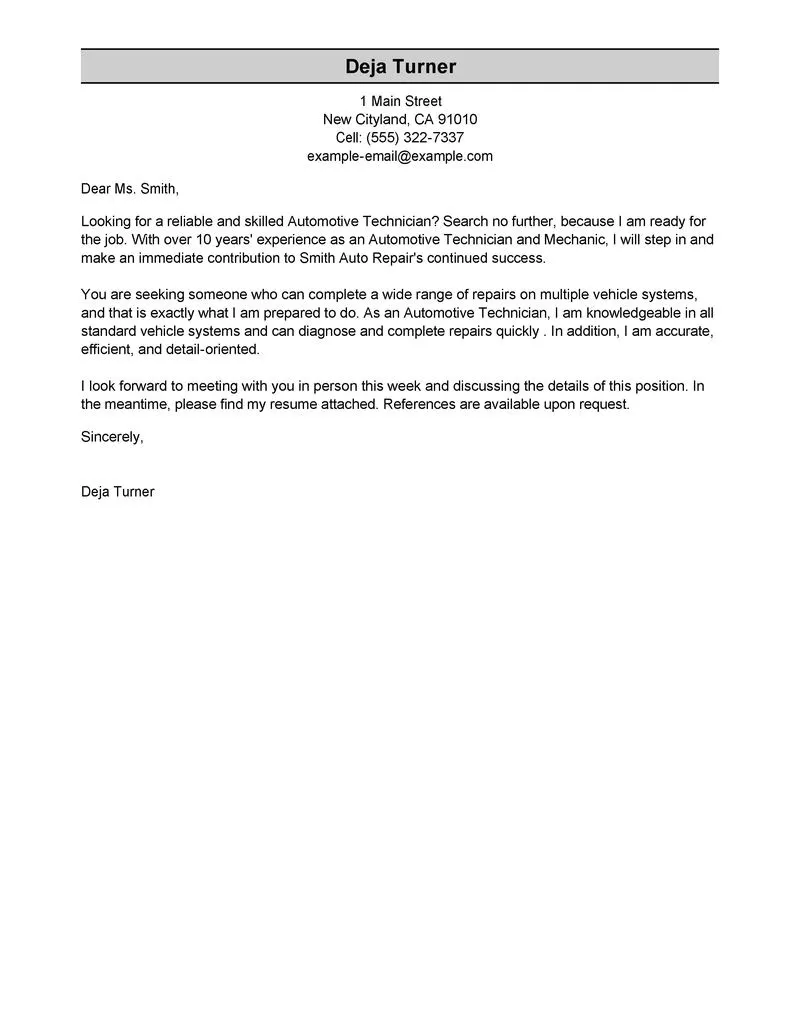Understanding the Automotive Cover Letter
In the competitive automotive industry, a well-crafted cover letter is your first chance to make a strong impression. It’s more than just a formality; it’s your opportunity to showcase your unique qualifications, passion, and suitability for a specific role. Unlike a resume that lists your experiences, a cover letter allows you to tell a compelling story, connecting your skills and experiences to the specific requirements of the job. A great automotive cover letter can be the deciding factor between getting an interview and getting overlooked, especially in a field where technical expertise and industry knowledge are highly valued. It gives the hiring manager a preview of who you are, what you can do, and why you are the best candidate. It is your first opportunity to shine and is where you demonstrate your ability to communicate effectively, a crucial skill in any professional setting. So, the importance of creating a comprehensive and tailored cover letter cannot be overstated.
Why a Cover Letter Matters in Automotive
The automotive industry is dynamic, and a cover letter provides context to your resume. It lets you highlight specific achievements relevant to the job description, emphasizing how your skills meet the employer’s needs. For instance, if the job requires expertise in a specific automotive technology or a particular type of vehicle maintenance, you can highlight your experience directly related to those areas. A strong cover letter demonstrates that you’ve researched the company and understand its values, showing that you’re genuinely interested in the opportunity and not just applying for any available position. This focused approach demonstrates your interest and initiative, significantly increasing your chances of getting an interview. This also allows you to personalize your application, demonstrating that you’re not just sending a generic resume, which demonstrates an interest that is critical to getting hired in the competitive automotive landscape.
Highlighting Your Skills
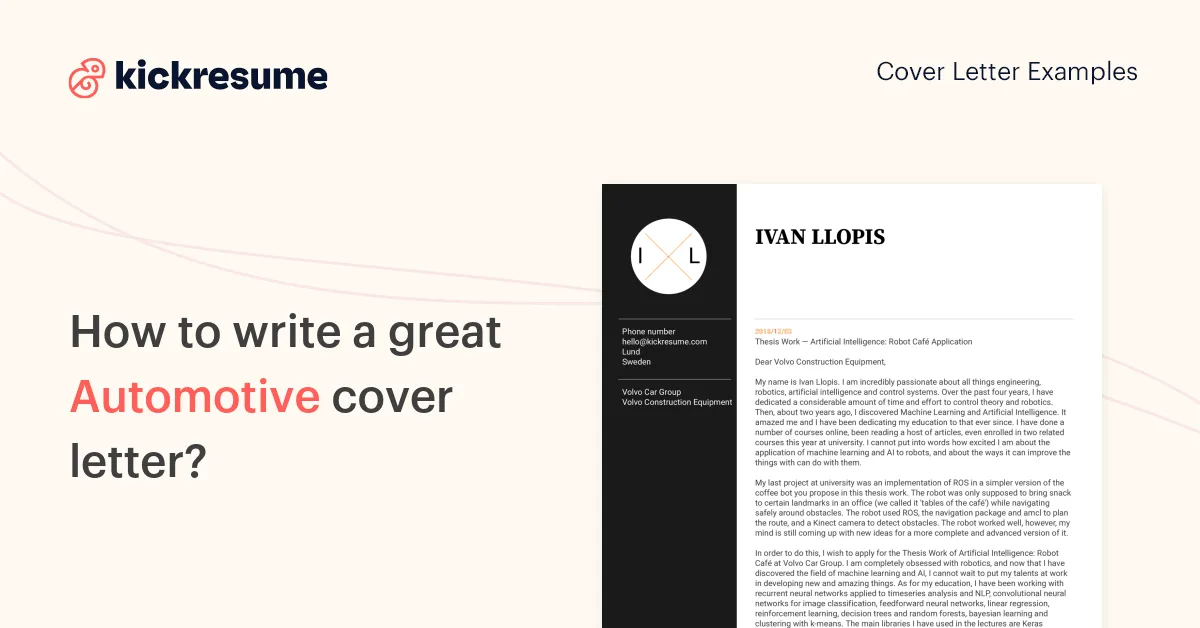
Your cover letter should spotlight the skills that make you stand out in the automotive industry. This includes technical skills such as proficiency in diagnostic equipment, knowledge of vehicle systems (engines, transmissions, electrical, etc.), and familiarity with specific software or tools. Also, showcase soft skills like problem-solving, communication, and teamwork, which are essential for collaborative environments and effective customer service. To do this effectively, carefully review the job description and identify the key skills the employer seeks. Then, provide concise examples of how you’ve applied these skills in previous roles. For example, if the job requires experience with a specific diagnostic tool, mention your experience with that tool and any successful projects you’ve completed using it. Demonstrate your competency by sharing how your skills translated into tangible results for your previous employers, and make sure that it aligns with the job’s requirements. By clearly illustrating these abilities, you show the hiring manager that you possess the skills to succeed in the role and the organization.
Quantify Achievements
Instead of simply listing responsibilities, quantify your achievements to make a lasting impact. Use numbers, percentages, and specific data to illustrate your success. For instance, instead of saying ‘Managed a team,’ state ‘Led a team of 10 technicians, increasing shop efficiency by 15%’. When you quantify your accomplishments, you provide tangible evidence of your capabilities and the value you bring to the table. This approach makes your cover letter more compelling and credible. Examples of quantifiable achievements could be the number of vehicles serviced per day, the reduction in repair times, the improvement in customer satisfaction scores, or the cost savings you’ve achieved through efficient operations. These figures give potential employers a clear understanding of your impact in previous roles and how you can contribute to their organization. Remember to focus on the results that align with the job’s objectives, demonstrating your understanding of the company’s priorities and your ability to meet them.
Showcase Relevant Experience
Detail your experience in a way that directly relates to the job requirements. For instance, if you’re applying for a role as a service advisor, emphasize your experience in customer service, communication, and sales. If you’re seeking a technician position, highlight your technical skills, certifications, and familiarity with specific automotive systems. Use the job description as a guide to identify which experiences are most relevant. Provide specific examples of how you’ve handled tasks similar to those outlined in the job description. This might include troubleshooting complex issues, managing customer expectations, or working with a team to achieve common goals. By providing concrete examples of your accomplishments, you provide evidence of your past successes that are easy for the hiring manager to grasp, and in doing so, make you a strong contender.
Demonstrating Passion for Automotive
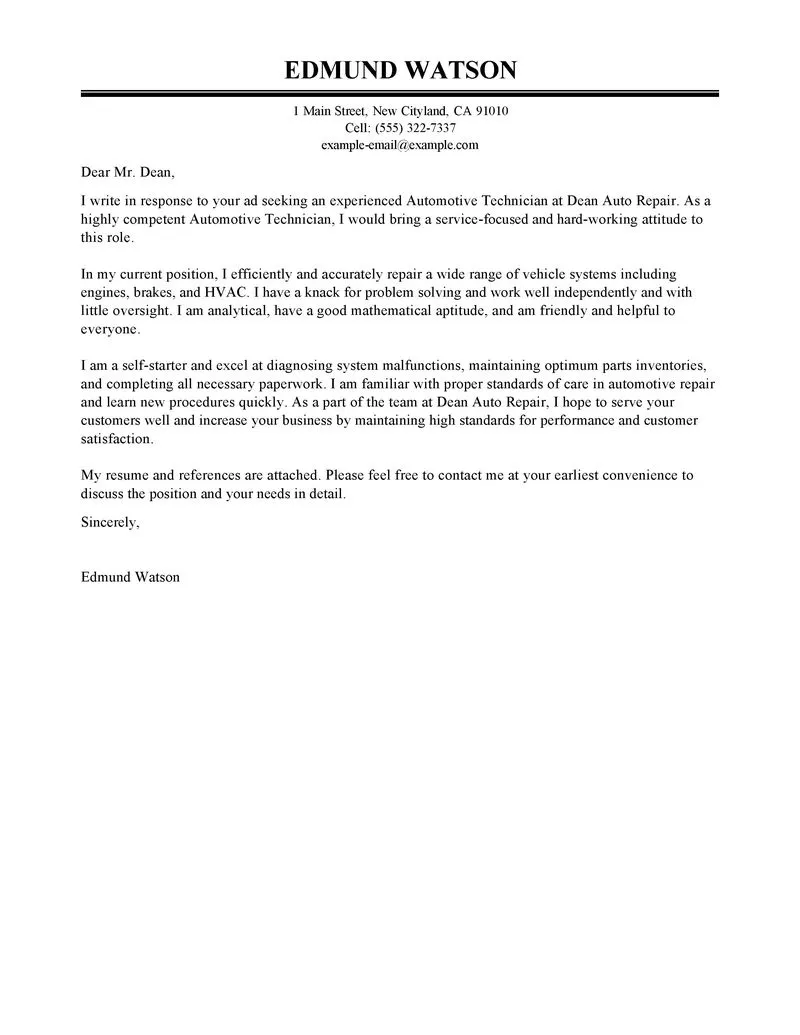
Showcasing your passion for the automotive industry is important. Share your enthusiasm for cars, technology, and the industry. This can be done by discussing your personal interests, projects, or any special knowledge you have of automotive trends, and make your cover letter memorable. This allows the hiring manager to understand your motivation and commitment to the industry. Share your specific interests in the automotive field, whether it’s electric vehicles, high-performance engines, or classic cars. If you have any certifications or training programs you have completed, mention them to show your commitment to continuous learning. Demonstrate your interest in the automotive industry by providing information about what you enjoy doing and your knowledge of vehicles, which allows the reader to grasp what makes you the best candidate.
Research the Company
A crucial step is to research the company to show you’re genuinely interested in the specific opportunity. Visit the company’s website, social media profiles, and any recent press releases to get a sense of its mission, values, and current projects. Tailor your cover letter to address the company’s needs and goals. Mention specific products, services, or initiatives that resonate with you, demonstrating that you’ve taken the time to understand the organization. This shows that you are not just sending a generic application, but that you have a real interest in being a part of their team. Knowing about a company’s recent innovations, industry awards, or community involvement can give you context and show that you are invested in their success. Make sure your research is reflected in your cover letter to leave a lasting impression on the hiring manager.
Tailor Your Letter
Personalize each cover letter to fit the specific job. Avoid using a generic template that doesn’t address the unique requirements of the role. This personalization can come from the skills you highlight, the experiences you emphasize, and the examples you provide. Review the job description closely and align your skills and experiences with the employer’s requirements. Mention specific projects, technologies, or challenges that the company is facing and describe how your background can contribute to their success. If possible, address the cover letter to the hiring manager by name. Tailoring your letter is vital to your application because it shows your genuine interest in the specific opportunity and significantly increases your chances of getting an interview. The more relevant your application is, the better your chances of impressing the hiring manager.
Formatting and Structure
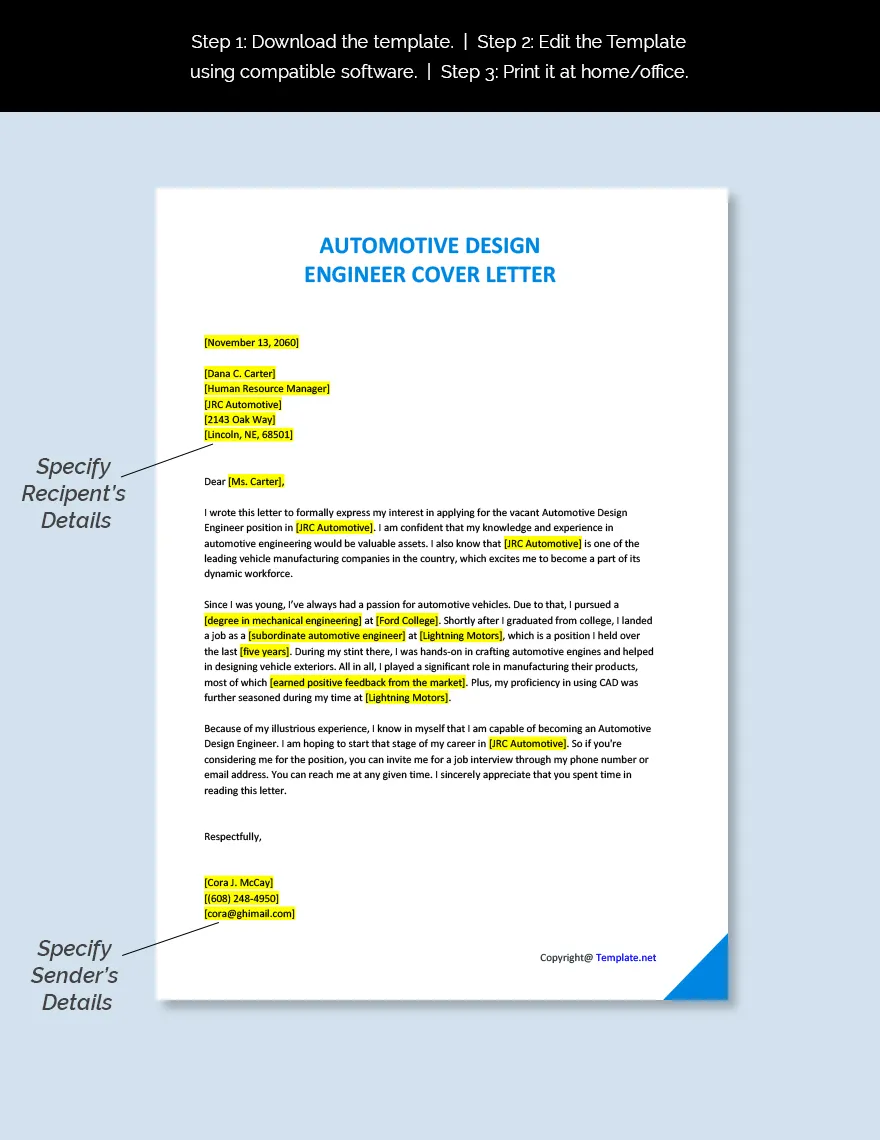
A well-structured cover letter is easy to read and highlights key information effectively. Use a professional font and maintain consistent formatting throughout. Typically, a cover letter should be one page long, with clear sections, including an introduction, a body, and a conclusion. The introduction should grab the reader’s attention and state the position you’re applying for. The body should highlight your skills, experience, and achievements, as they relate to the job description. Each paragraph should focus on a specific aspect of your qualifications, and be concise and well-written. Keep paragraphs brief and to the point, using bullet points when necessary. Use a professional font, such as Arial or Times New Roman, in a readable size (11 or 12 points), with consistent spacing. Ensure that the layout is clean and visually appealing to the reader, which will make the application process more seamless.
Keep it Concise
Your cover letter should be concise, usually no more than one page. Get straight to the point, highlighting the most relevant information about your skills, experience, and achievements. Avoid using unnecessary jargon or lengthy explanations. Focus on what you can offer the employer, emphasizing the value you bring to the role. To be concise, focus on providing impactful information. Use strong action verbs and avoid repeating details that are already present in your resume. Be clear and direct in expressing your qualifications and your interest in the position. Every sentence should serve a purpose. Make sure that the letter is easy to read to ensure that the hiring manager doesn’t waste time trying to figure out what you have to offer.
Proofread Carefully
Proofread your cover letter multiple times to eliminate any errors in grammar, spelling, and punctuation. Typos and grammatical errors can undermine your credibility, and it is important that the document reflects your attention to detail and professionalism. Read your cover letter aloud to catch any awkward phrasing or structural issues. Ask a friend, family member, or career counselor to review it for any potential mistakes. This process will not only ensure that the application is error-free, but also show the hiring manager your attention to detail and give a great first impression. Ensure you use a grammar checker, as this will help catch many errors before your application is sent.
Call to Action and Closing
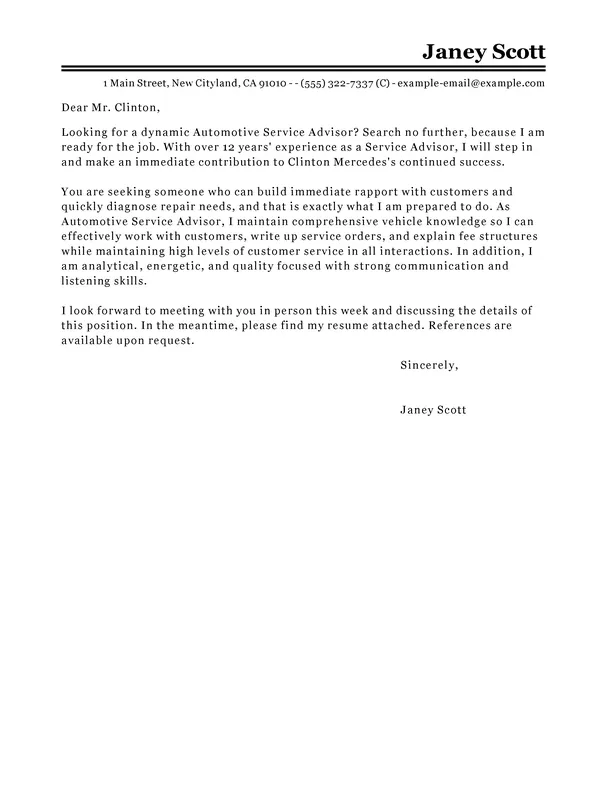
Your closing should leave a strong, lasting impression. It is the last thing a hiring manager reads. Include a call to action that encourages the reader to move forward, such as expressing your availability for an interview and offering your contact information. Close with a professional salutation, such as ‘Sincerely’ or ‘Best regards.’ It is important to clearly state your interest in the position and reiterate your enthusiasm for the opportunity. Keep the closing section brief and to the point, and thank the hiring manager for considering your application. This allows you to end the application process on a high note, creating a positive last impression and increasing the chances of landing an interview.
Express Enthusiasm
Convey your enthusiasm for the position and the company throughout your cover letter. Share your excitement for the opportunity, demonstrating that you are passionate about the automotive industry. Make sure that your interest is genuine and sincere, but make sure it’s relevant to the specific role. If you are genuinely excited about an opportunity, make it known. If you’re enthusiastic about working with a specific brand of vehicle, or if you admire the company’s values or innovations, mention these aspects to show your genuine interest. By expressing your enthusiasm, you’ll make your application more memorable and show that you’re not just looking for a job but an opportunity to contribute.
Provide Contact Information
Make it easy for the hiring manager to contact you. Provide your phone number, email address, and any other relevant contact information, such as your LinkedIn profile URL. This ensures that the recruiter can reach you quickly if they’re interested in scheduling an interview. Double-check your contact details for accuracy, and ensure that your voicemail is set up professionally. Including your LinkedIn profile allows the hiring manager to learn more about your professional background and network. Keep all your information up-to-date and professional, and provide them with the means of contacting you so they can reach you quickly and easily.
